Editorial
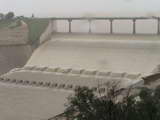
Joy untold! Large areas of the state of Queensland, Australia, saw rains during January unlike any seen since 1998. There is a down-side as some areas are now both in both drought and flood. Even though whole towns had to be evacuated, the mood is generally positive. The state's second largest dam has water flowing over the spillway for the first time in seventeen years (that would be living memory for some of the residents). Another rural area where farmers have been restricted to 13% of their allowed irrigation water allocation for the past three years estimate that they have sufficient to go to 100% for the next three. In Brisbane, we still suffer under "Level Six" water restrictions, despite water falling in the catchment. Why am I not surprised that authorities are quick to take and slow to give? But considering that we are by no means out of the woods yet, a bit of conservatism is understandable. Besides, if they relax the restrictions far enough, I'll no longer have a valid excuse for not washing the car!
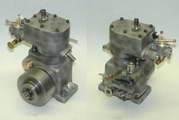
January has been a good month for new Member support too, with many self-confessed Lurkers proudly becoming paid-up Supporters. And as you will read below, this would be a good time to support the site by buying the MEN DVD in preparation for the March Free Plan release. The subject this time will be a four-stroke, further increasing the spread of types released to Members over the past years. Preliminary work on the plan demanded a fair chunk of my work-shop time for January, so progress on the Whippets has not been as extensive as in past months, but as I compose this on Jan 28th, the #1 engine is completely finished and assembled, ready for testing (ok, there's one small omission, detection of which I'll leave as an exercise to the reader). The #2 engine is ready for final assembly with the exception of the timer assembly. As an experiment, its timer will be modified to use a Hall-effect device (pointless ignition  ). I'll skip a Whippet news item, but if you go to the main Whippet page, or check the New and Updated Pages page, you'll find the next installments in the Whippet construction series.
). I'll skip a Whippet news item, but if you go to the main Whippet page, or check the New and Updated Pages page, you'll find the next installments in the Whippet construction series.
Find Fixed

I'm SO embarrassed. Late in January, I spotted some rather anomalous behavior in the Site Search Facility that led me to conclude that any search request which specified more than one search term to be found in the same document for a "hit", was instead returning all documents that containing the first term specified for the request. I know this was tested way back when, but somewhere along the line, some tweak I made—probably to speed up the search—introduced the bug and my QA process let this slip through into production, and onto the DVDs. Anyway, it's all fixed and works as advertised now. Here's the test: specify topsy froggy as the terms and don't check any of the check boxes. You should get eleven (11) hits. Now repeat with the ALL checkbox selected. You should see only two documents. If you are a Member and use the search facility within a local web server, the latest versions of all the black magic script thingies can be downloaded from (wait for it) the downloads page.
2008 Show Calendar
Nemett emailed to let us know that the annual Model Engineer Exhibition for 2008 will be held from the 19th through 21st of September. Once again, it will be at Ascot. The show hosted by Engineering in Miniature, the other British magazine for model engineers, took place over the 18th to 20th of January at Alexandra Palace, London—meaning you've either seen it, or missed it. And for completeness, the Midlands Model Engineering Exhibition will be held at Lamington Spa from October 17th through the 21st.
On the other side of the pond, Carl Carlsen wrote that the annual GEARS show will be a bit early this year. The venue remains the Old Portland Armory, but the date has had to be shifted to the Labour Day weekend, August 30 to the 31st. Photos from previous GEARS shows can be seen on Cap'n Carl's web site. Now, if I can find a good metadata conference on the West Coast about that time...
Micron Confession
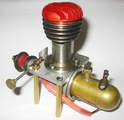
There was a small error in Sheet 2 of the Micron 5cc plan set issued to Model Engine News Members last December. Really, it is minor; the wrist pin material call-out was given as 3mm drill rod when Blind Freddy and his dog could see from the drawing dimensions it should have been 4mm stock. But an error is an error, is an error, so that sheet has been revised and the downloadable update for this month contains the complete new set of drawings for the engine. Thanks go to the eagle-eyed member who spotted this—perhaps because he owns a strikingly handsome example of the engine in question, pictured here.
Keeping FIT
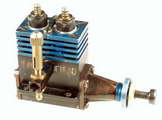
Remember the Czech Model Engines book reviewed here last month? While leafing through it, a group of engines designed by František Ježdík with the name "FIT" jumped out at me. Virtually at the same time, an email arrived questioning the origin attributed to the FIT photos in the Engine Finder. What can I say? How about oops! (followed by a big sorry to Mr Ježdík). The Country of Origin for the Finder entries has been corrected, which automatically moves all the FITs into the "New and Updated" list for this month only. By remarkable coincidence, the engine that follows the FIT series in the Czech Engines book is none other than the Vltavan 10 In-line Twin restored by Adrian Duncan not long ago. Guess who made it? Yup! None other than Mr FIT himself, František Ježdík.
100.15°

Despite the salt content, blood is basically water and boils at so close to 100° Celsius that you'd be hard pressed to measure the difference. And what, you may ask, does that have to do with model engines and engineering? Well recall that last year marked the centenary of Sir Frank Whittle's birth. This year marks another such centenary, this time for Sir Frank's fellow countryman, Ian Fleming, the author of the so-so James Bond series of novels that gave rise to the mega-movie franchise. So to mark this glorious, world-as-we-know-it changing occasion, the highly esteemed Goon Show, sorry, the British Royal Mail, is issuing a special set of stamps. Reading this induced the sudden interest regarding the boiling point of blood in order to assess precisely how much danger I might be facing!
I've calmed down now and the answer is obvious. The "James Bond" franchise is Big Business and a large part of it is promotion and "brand awareness". So, you might argue, are airlines. But there is no strong name recognition; we don't strap ourselves into the high priced torture seat uttering thanks to Sir Frank. If anything, we just want it to be over, and soon! The 007 marketeers on the other hand want it in our faces all the time and having strong lobby power, probably played some part in the commissioning of those stamps (and don't start me on why there is so much gratuitous tobacco use in films and TV programs). No such unified lobby group exists for the gas turbine. Then there's National Pride and Prejudice to consider; Hans von Ohain was definitely first with an air-worthy gas turbine and contrary to some sources, there is near enough to zero doubt that it was an independent development. His centenary is three years away (2011). That will probably pass quietly too unless a strong, vocal group forms to pressure governments into some form of public recognition. Sure hope someone takes up this challenge...
Bar-Stock F2B Engine Design
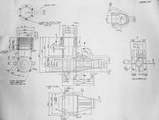
Due to a sadly diminished annoyance threshold brought on by advancing age, I keep clear of on-line "forums", so it's good to have cheerful MEN readers around who can brave the moronosphere and let me know about the gold that occasionally bobs up... sinks down... whatever. One such is Charlie Stone, respected control line modeler from Western Australia who emailed about a worthwhile thread on the Stuka Stunt list. Seems Brian Turner, known for his work in F2C is—if you'll pardon the pun—turning his hand to the design of a serious competition grade F2B engine.
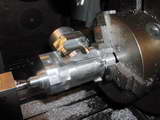
The start of the thread outlining the project and showing the basic drawings may be read
here.
Actual construction progress appears under a different thread for some reason, which you can view from
here.
How long these links will remain valid, I've no idea, so good lock if you are not reading this close to February 2008! As seen in the first thread, the design is a well thought out, relatively conventional, cross-flow, AAC, TBR, FRV, RE. The designer says it represents a distillation of prior development work based on the Russian Stalker engines (no slight intended; the Stalker is at the current tip of progressive two-stroke F2B engine design). I'm pleased to see that the rear exhaust is intended for a simple expansion muffler, not a tuned pipe. Both help greatly with the model design as well as keeping it relatively gunk-free in service, but tuned pipes seem to require that the time which should be spent practicing the pattern gets redirected into fiddling with the pipe. The intake is offset from the shaft centerline to extend the inlet period without having to make a giant cut-out in the crankshaft (as explained on FRV Timing page) and transfer is directed, Dooling style, through the piston which helps with wrist pin lubrication and heat dissipation. The hand drafted plans look complete and readable enough to allow an experienced builder to start cutting metal, but I'd wait a bit. This is a thread that will be worth revisiting from time to time.
A New Original Ohlsson
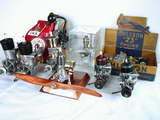
Just in case you though Les Stone has been quiet of late, he has an excuse in the form of a Command Performance on an ocean cruise. But he is back in harness now, turning out engines faster than most of us can turn out lights. This month, it's an Original Ohlsson from one of Roger Schroeder's Classic kits. Les admits to having an Ohlsson and Rice fixation as can be guessed from this photo of his new and reproduction (O&R) engines. The latest addition is in the foreground. Les reports increasing the compression ratio on his Original Ohlsson, which is something I must try on my own example, some day. Be sure to have a look at the updated to the Les Stone and Roger Schroeder Tribute Pages.
Vega Revisited

Normally, the Engine of the Month passes by quietly into obscurity without comment, so it came as a pleasant surprise when the Vega Four-Strokes that appeared here last month brought a veritable torrent of emails (three to be precise, but that's three more than usual). All were very kind and remarked on the scarcity of information about these engines, welcoming the tiny amount I was able to dredge up. Deitmar Kolb in cold and icy Germany referenced me to the Vega photos on his own website—one well worth visiting to see his beautiful and unusual four-stroke collection. Even better, I now have on loan the example that started it all and having carefully dismantled the engine, I've been able to provide all new photos and a better, expanded, technical description, so be sure to have another look at the Vega page.
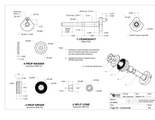 Now I'm sure the illustration heading this news item can't have escaped your notice. Yes, it's a "phantom" Vega 30, created using the 3D parametric modeling package mentioned last month. Tradition here for the past several years has been to mark my Ides of March birthday by presenting MEN Members with a complete set of plans for a model engine. So no prizes for guessing that this will be the Vega 30, the first engine I've drawn up using Alibre Design. When reviewing the package, I expressed some dissatisfaction with the 3D to 2D process. This turned out mostly to be learning-curve related and I am now very happy with the process. In fact, I believe it to be superior to "traditional" CAD in just about every way. The sample drawing seen here was produced in about 30 minutes, excluding the time spent making the 3D models involved. So, Members: you have something to look forward to next month, and non-members may have yet another reason to become Members
Now I'm sure the illustration heading this news item can't have escaped your notice. Yes, it's a "phantom" Vega 30, created using the 3D parametric modeling package mentioned last month. Tradition here for the past several years has been to mark my Ides of March birthday by presenting MEN Members with a complete set of plans for a model engine. So no prizes for guessing that this will be the Vega 30, the first engine I've drawn up using Alibre Design. When reviewing the package, I expressed some dissatisfaction with the 3D to 2D process. This turned out mostly to be learning-curve related and I am now very happy with the process. In fact, I believe it to be superior to "traditional" CAD in just about every way. The sample drawing seen here was produced in about 30 minutes, excluding the time spent making the 3D models involved. So, Members: you have something to look forward to next month, and non-members may have yet another reason to become Members  .
.
PeeWee V4
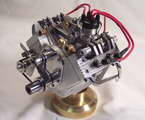
The late Bob Shore will be remembered by many for his excellent book on ignition coils for model engines, together with his model engine designs, such as the Hercules, Sliver Bullet, and Eagle. Another project, the PeeWee (Bob's nick-name for his wife, Margaret), was not 100% complete at the time of his death, but by agreement with the family, plans and castings from Bob's original patterns are available from Dirk Tollenaar, McKinney, TX, USA. Dirk's name will be familiar to many from all the Internet Forums he moderates, including several dedicated to Edgar T Westbury and his many designs.

The PeeWee V4 kit from Dirk comprises six castings in 356 aluminum, sand blasted and heat treated to the -T6 condition for strength and machinability. The coring is simple, but very accurate and the finish is first-class. Based on recent experience, I took a trial cut across one and found the way that the alloy took the cut to be excellent. The odd "L" shaped things in the photo are the cylinder heads with full length rocker posts which will be mostly machined away during construction.
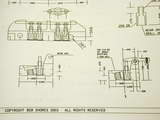 The plan pack included with the engine comprises twenty-one 11x17 pages of CAD drawings, plus reprints of Bob's cam cutting jig article that appeared in SIC, Jerry Kieffer's Sherline Headstock based Model Engine Camshaft Grinder article, and other useful data. Producing a fully detailed set of CAD drawings for any model engine is a BIG job (trust me, I've done over 60 of these, so I like to think I know a little about it). Bob's drawings have an unfinished look to them. Sections are not cross-hatched, visible lines are absent, and dimensions are a bit light-on, though I was able to ultimately find a dimension for the ones I checked, even if it was not on the view I was looking at. Dirk notes in the accompanying history that the plans were not completed, but as far as I can tell without doing a build, all the important information is there. Plus, anyone experienced enough to tackle a water cooled, OHV four-stroke V-4 project will be able to work around any missing dimensions.
The plan pack included with the engine comprises twenty-one 11x17 pages of CAD drawings, plus reprints of Bob's cam cutting jig article that appeared in SIC, Jerry Kieffer's Sherline Headstock based Model Engine Camshaft Grinder article, and other useful data. Producing a fully detailed set of CAD drawings for any model engine is a BIG job (trust me, I've done over 60 of these, so I like to think I know a little about it). Bob's drawings have an unfinished look to them. Sections are not cross-hatched, visible lines are absent, and dimensions are a bit light-on, though I was able to ultimately find a dimension for the ones I checked, even if it was not on the view I was looking at. Dirk notes in the accompanying history that the plans were not completed, but as far as I can tell without doing a build, all the important information is there. Plus, anyone experienced enough to tackle a water cooled, OHV four-stroke V-4 project will be able to work around any missing dimensions.
If you'd like to build one of these, the plans and castings as seen here are available from Dirk Tollenaar for US$185.00, plus shipping. Dirk is also working on making plans for a suitable radiator available. There's a picture of this, plus a PeeWee under construction on page 11 of the Engine Gallery. Naturally, Dirk moderates a Bob Shores related Forum. If you'd like to join this, or some other model engine related forum, have a look at the new Model Engine Related Forums section of the Links Page.
New Books and Magazines This Month
When I started building my home machine shop, I was buying just about all the books on the operation of basic machine tools I could find. Some, like George H Thomas' Model Engineers' Workshop Manual I found very useful, others less so. As my skills increased, I found that the things I needed to know were not in any books. The simple ones now told me nothing I hadn't already been told, or figured out for myself, while the more advanced ones were oriented towards "professional" shops with equipment I'll never own, making the material all a bit academic. So I've been ignoring new books of this type and using the ones in my library as references on odd occasions. The result is while I've been aware of Machine Shop Trade Secrets since it came out in '04, I've ignored it as probably having nothing special to offer for either of the two preceding reasons. Well, how wrong can one person be?!
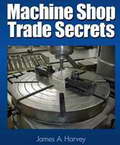 Late in 2007, a spam-ish email got posted on one of the few Forums that I subscribe to. While not 100% on target for the forum, it was not way off beam either and had the desired effect in leading me to an extract from the book on the arcane art of knurling. That in turn led to revision of the No New Machining Books policy, and this month's new book: Machine Shop Trade Secrets by James A Harvey, ProShop Publishing 2004, ISBN 0-9743897-6-5. After a scan of the Table of Contents, I generally read the Introduction or Preface fully, then sample things that seem relevant. In this case, Chapter One, titled "Work Fast" looked good. It was, so this led to Chapter two, "Get It Right", followed by Chapter three, followed by... By the end of a long day, I was amazed to discover that I'd read the entire thing cover to cover: some 300 odd pages, well illustrated with photographs and an appendix of plans for simple but useful tools you can't buy from any catalogue.
Late in 2007, a spam-ish email got posted on one of the few Forums that I subscribe to. While not 100% on target for the forum, it was not way off beam either and had the desired effect in leading me to an extract from the book on the arcane art of knurling. That in turn led to revision of the No New Machining Books policy, and this month's new book: Machine Shop Trade Secrets by James A Harvey, ProShop Publishing 2004, ISBN 0-9743897-6-5. After a scan of the Table of Contents, I generally read the Introduction or Preface fully, then sample things that seem relevant. In this case, Chapter One, titled "Work Fast" looked good. It was, so this led to Chapter two, "Get It Right", followed by Chapter three, followed by... By the end of a long day, I was amazed to discover that I'd read the entire thing cover to cover: some 300 odd pages, well illustrated with photographs and an appendix of plans for simple but useful tools you can't buy from any catalogue.
Author James Harvey is a "Tool Room" machinist with thirty years experience. In his work, he's called upon to produce prototypes, build and maintain tools such as dies, moulds, fixtures, and (he says but I don't believe him), occasionally sweep the floor. His book is a collection of techniques and tips that will help you work better and faster. The audience for this book is remarkably broad. There's tips in here that a raw beginner will understand, as well as stuff a beginner will not be ready for, but which may make sense to them later, if they remember it. I saw a number of techniques that I've worked out for myself the hard way, a lot I've not yet worked out, and more then one or two I don't even understand (yet  ). And while James is writing for "The Trade", that in no way diminishes the value of the book to model engineers and amateur machinists. Almost all our models can be considered "prototypes" and while we all want to do the best work we can, everyone's time is valuable and a book that helps us make better use of it is worthwhile having.
). And while James is writing for "The Trade", that in no way diminishes the value of the book to model engineers and amateur machinists. Almost all our models can be considered "prototypes" and while we all want to do the best work we can, everyone's time is valuable and a book that helps us make better use of it is worthwhile having.

Before I give an example, I'd better give the customary overview of the book. It contains 18 Chapters and three appendices. Each chapter focuses on some aspect of equipment, or category or work. They begin with some words to set the scene, then continue with numbered tips. Each has a descriptive name and just enough words to flesh it out (unlike my writing, I'm afraid). Take an example from Chapter Six on "Shop Talk": Use hydraulics to remove bushings pressed into blind holes. I've heard this one before and while I've never had to use it, I'm sure I will, someday. Each chapter is full of these. Some may seem to have little relevance to you, such as the chapter on CNC, or the one on surface grinders, but they are worth reading anyway as ultimately, everything is interrelated.
The example I'll quote is the cure to what has been one of life's frustrations to me, relating to what I'm fond of calling the pile of junk mill/drill that sits in my shop. This is saved from the garbage tip by a good, commercial grade digital readout (DRO) that allows precise positioning irrespective, or perhaps in spite of the two un-funny jokes that the maker chose to install in place of lead screws and nuts. I generally avoid tightening the table clamps because I've noticed that this may cause the table to shift by a thou or more, so I leave them loose and keep an eye on the DRO as the table is moved on the other axis. Enter Tip #25, page 46: Remove handle pressure to keep machine tables from drifting off location. A single paragraph of explanation as to why follows, but the main value is the tip itself and knowing that it is not just me; this is a known problem with a known answer, and it works! Tips like this are beyond price. By rough count, the book contains 619 of them.
Machine Shop Trade Secrets is available on-line from the author's web site at ProShop Publishing using PayPal (tell them you saw it on Model Engine News), or you can order it from Amazon for the same price. I rate this as a full Five Star book  .
.
Engine Of The Month: The WAF

What? Never heard of it? I'm not surprised and have to confess that apart from knowing that the name stood for something Continental, I did not know a lot about these engines either. Prompted by pictures from Adrian Duncan of an unusual WAF-35, followed by a coincidental request from a reader for information on a WAF-1, what we have been able to state with some degree of authority about these engines and their designer, Herr Walter A Frisch, has been collected and made into two quickie review pages. So now you see where the "WAF" came from and that it has nothing whatsoever to do with Women, nor Air Forces! Click the links, or consult the Finder for the low-down...
Tech Tip of the Month

Mr Engine-uity, Roger Schroeder, fielded a request last month for details on piston ring making for model engines. Being efficient (never lazy  ), Roger looked up the list of How-To techniques to see what this site had to offer. Finding nothing there, he alerted me to this ghastly oversight, which I now correct by the addition of a new How-To on Piston Rings. This page considers the requirements, possible manufacturing techniques, and contains links to projects that detail the process. And yes, there was a Tech Tip on this way back, but the subject deserves a better, more comprehensive treatment, which it now has!
), Roger looked up the list of How-To techniques to see what this site had to offer. Finding nothing there, he alerted me to this ghastly oversight, which I now correct by the addition of a new How-To on Piston Rings. This page considers the requirements, possible manufacturing techniques, and contains links to projects that detail the process. And yes, there was a Tech Tip on this way back, but the subject deserves a better, more comprehensive treatment, which it now has!
What is it with these people?!
For the third time in this web site's ten year history, I've got an irate email from a "revolutionary engine developer" making vague threats of litigation over mere mention of a name! I can only think that the competition is so fierce because the prize is so small. Well I've had it being nice to people who can't compose a polite message to people they don't know. In this case, there is a simple solution: you won't find any links to a certain Scotch-yoke engine concept on the links page anymore. Whose loss is that, I wonder...
 Find Fixed
Find Fixed
 2008 Show Calendar
2008 Show Calendar
 Micron Confession
Micron Confession
 Keeping FIT
Keeping FIT
 100.15°
100.15°
 Bar-stock F2B engine design
Bar-stock F2B engine design
 A New Original Ohlsson
A New Original Ohlsson
 Vega Revisited
Vega Revisited
 PeeWee V4
PeeWee V4
 What is it with these people?!
What is it with these people?!
 Editorial
Editorial
 New Books and Magazines This Month
New Books and Magazines This Month
 Engine Of The Month: The WAF
Engine Of The Month: The WAF
 Tech Tip of the Month
Tech Tip of the Month
 Standard Stuff
Standard Stuff



 ). I'll skip a Whippet news item, but if you
). I'll skip a Whippet news item, but if you 













 .
.

